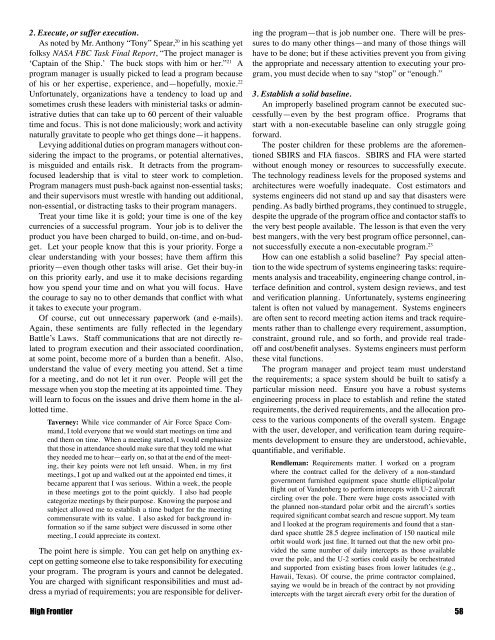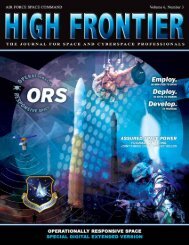Space Acquisition - Air Force Space Command
Space Acquisition - Air Force Space Command
Space Acquisition - Air Force Space Command
You also want an ePaper? Increase the reach of your titles
YUMPU automatically turns print PDFs into web optimized ePapers that Google loves.
2. Execute, or suffer execution.<br />
As noted by Mr. Anthony “Tony” Spear, 20 in his scathing yet<br />
folksy NASA FBC Task Final Report, “The project manager is<br />
‘Captain of the Ship.’ The buck stops with him or her.” 21 A<br />
program manager is usually picked to lead a program because<br />
of his or her expertise, experience, and—hopefully, moxie. 22<br />
Unfortunately, organizations have a tendency to load up and<br />
sometimes crush these leaders with ministerial tasks or administrative<br />
duties that can take up to 60 percent of their valuable<br />
time and focus. This is not done maliciously; work and activity<br />
naturally gravitate to people who get things done—it happens.<br />
Levying additional duties on program managers without considering<br />
the impact to the programs, or potential alternatives,<br />
is misguided and entails risk. It detracts from the programfocused<br />
leadership that is vital to steer work to completion.<br />
Program managers must push-back against non-essential tasks;<br />
and their supervisors must wrestle with handing out additional,<br />
non-essential, or distracting tasks to their program managers.<br />
Treat your time like it is gold; your time is one of the key<br />
currencies of a successful program. Your job is to deliver the<br />
product you have been charged to build, on-time, and on-budget.<br />
Let your people know that this is your priority. Forge a<br />
clear understanding with your bosses; have them affirm this<br />
priority—even though other tasks will arise. Get their buy-in<br />
on this priority early, and use it to make decisions regarding<br />
how you spend your time and on what you will focus. Have<br />
the courage to say no to other demands that conflict with what<br />
it takes to execute your program.<br />
Of course, cut out unnecessary paperwork (and e-mails).<br />
Again, these sentiments are fully reflected in the legendary<br />
Battle’s Laws. Staff communications that are not directly related<br />
to program execution and their associated coordination,<br />
at some point, become more of a burden than a benefit. Also,<br />
understand the value of every meeting you attend. Set a time<br />
for a meeting, and do not let it run over. People will get the<br />
message when you stop the meeting at its appointed time. They<br />
will learn to focus on the issues and drive them home in the allotted<br />
time.<br />
Taverney: While vice commander of <strong>Air</strong> <strong>Force</strong> <strong>Space</strong> <strong>Command</strong>,<br />
I told everyone that we would start meetings on time and<br />
end them on time. When a meeting started, I would emphasize<br />
that those in attendance should make sure that they told me what<br />
they needed me to hear—early on, so that at the end of the meeting,<br />
their key points were not left unsaid. When, in my first<br />
meetings, I got up and walked out at the appointed end times, it<br />
became apparent that I was serious. Within a week, the people<br />
in these meetings got to the point quickly. I also had people<br />
categorize meetings by their purpose. Knowing the purpose and<br />
subject allowed me to establish a time budget for the meeting<br />
commensurate with its value. I also asked for background information<br />
so if the same subject were discussed in some other<br />
meeting, I could appreciate its context.<br />
The point here is simple. You can get help on anything except<br />
on getting someone else to take responsibility for executing<br />
your program. The program is yours and cannot be delegated.<br />
You are charged with significant responsibilities and must address<br />
a myriad of requirements; you are responsible for delivering<br />
the program—that is job number one. There will be pressures<br />
to do many other things—and many of those things will<br />
have to be done; but if these activities prevent you from giving<br />
the appropriate and necessary attention to executing your program,<br />
you must decide when to say “stop” or “enough.”<br />
3. Establish a solid baseline.<br />
An improperly baselined program cannot be executed successfully—even<br />
by the best program office. Programs that<br />
start with a non-executable baseline can only struggle going<br />
forward.<br />
The poster children for these problems are the aforementioned<br />
SBIRS and FIA fiascos. SBIRS and FIA were started<br />
without enough money or resources to successfully execute.<br />
The technology readiness levels for the proposed systems and<br />
architectures were woefully inadequate. Cost estimators and<br />
systems engineers did not stand up and say that disasters were<br />
pending. As badly birthed programs, they continued to struggle,<br />
despite the upgrade of the program office and contactor staffs to<br />
the very best people available. The lesson is that even the very<br />
best mangers, with the very best program office personnel, cannot<br />
successfully execute a non-executable program. 23<br />
How can one establish a solid baseline Pay special attention<br />
to the wide spectrum of systems engineering tasks: requirements<br />
analysis and traceability, engineering change control, interface<br />
definition and control, system design reviews, and test<br />
and verification planning. Unfortunately, systems engineering<br />
talent is often not valued by management. Systems engineers<br />
are often sent to record meeting action items and track requirements<br />
rather than to challenge every requirement, assumption,<br />
constraint, ground rule, and so forth, and provide real tradeoff<br />
and cost/benefit analyses. Systems engineers must perform<br />
these vital functions.<br />
The program manager and project team must understand<br />
the requirements; a space system should be built to satisfy a<br />
particular mission need. Ensure you have a robust systems<br />
engineering process in place to establish and refine the stated<br />
requirements, the derived requirements, and the allocation process<br />
to the various components of the overall system. Engage<br />
with the user, developer, and verification team during requirements<br />
development to ensure they are understood, achievable,<br />
quantifiable, and verifiable.<br />
Rendleman: Requirements matter. I worked on a program<br />
where the contract called for the delivery of a non-standard<br />
government furnished equipment space shuttle elliptical/polar<br />
flight out of Vandenberg to perform intercepts with U-2 aircraft<br />
circling over the pole. There were huge costs associated with<br />
the planned non-standard polar orbit and the aircraft’s sorties<br />
required significant combat search and rescue support. My team<br />
and I looked at the program requirements and found that a standard<br />
space shuttle 28.5 degree inclination of 150 nautical mile<br />
orbit would work just fine. It turned out that the new orbit provided<br />
the same number of daily intercepts as those available<br />
over the pole, and the U-2 sorties could easily be orchestrated<br />
and supported from existing bases from lower latitudes (e.g.,<br />
Hawaii, Texas). Of course, the prime contractor complained,<br />
saying we would be in breach of the contract by not providing<br />
intercepts with the target aircraft every orbit for the duration of<br />
High Frontier 58











